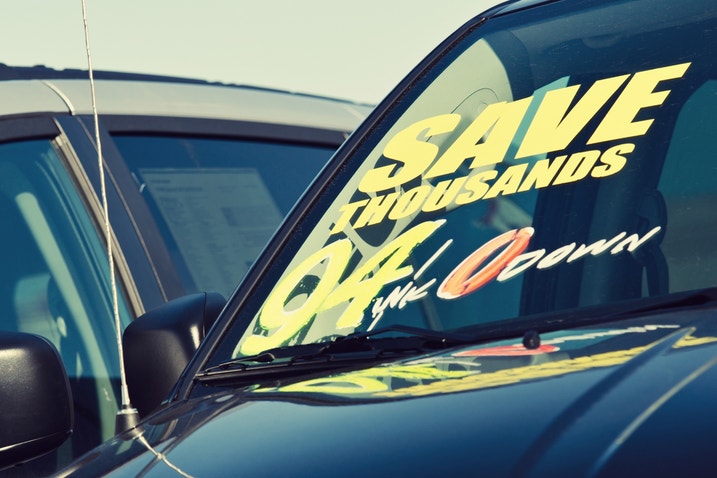What's the difference between a demo car, a program car, and a loaner?
Demo car: Car dealerships use demo cars for customer test drives when popular new models are in short supply, explains Chris Cutright, a former car salesman. Often, the dealership's managers also use demo cars for commuting. However, dealers do not always register demo cars, so the vehicles may still be considered new even with the added mileage. When their dealership duties are over, the cars go up for sale, usually with between 1,000 and 3,000 miles on their odometers. Demo cars come either from the dealership's own inventory or an auction at which the used-car manager purchased them, Cutright says.
Program car: Demos shouldn't be confused with what are called "program" cars, which are owned by manufacturers and given to employees to drive for a period of time. They're then distributed to dealers to sell, with up to 10,000 miles on the odometer.
Loaner car: Finally, "loaners" are cars that were once used as the temporary mode of transportation for customers whose vehicles were in the service department, either as a complimentary perk or in the place of a rental car. These could also be called "courtesy vehicles."
Demo cars: Pros and cons
Pros
- Lower price: You can often save a lot of money on a demo versus the exact same new model. "Buying or leasing a demo car can be a great deal if the price is right," says Dennis Rayfield, the former fleet manager for a Hollywood talent agency.
- Availability: If you're in the market for a very popular model, the dealership might not be able to get a new car for you. In that case, a demo could be your best bet. Rayfield notes that he also bought demos in cases where he couldn't find a car with the options and features a client wanted in the dealership's inventory.
- Condition: The vehicle has been in the dealership's possession for its entire life, so it's been looked after by the company's staff and mechanics. As a result, demo cars have usually been maintained to a high standard and should be in excellent condition.
- Warranty: Unlike a typical used car, some demo models give you the advantage of a new car warranty, which starts on the date you purchase the vehicle. However, some manufacturers start the warranty period when the car is first put in service, so that's something to check out before you commit.
- Rebates and incentives: Since many automakers and dealerships consider demo models to be new cars, they could qualify for various incentives, like rebates and discount financing. Such incentives could result in significant additional savings, so it's worth checking into.
- Features and extras: Dealerships' demos are usually "loaded" models with all the latest bells and whistles. Demo cars serve as a sales enticement for potential new-car customers, and buying one gives you the opportunity to get a fully equipped vehicle at a much better price than MSRP.
Cons
- A demo isn't always a great deal: Buying a demo car is a "potential" good opportunity, stresses Oren Weintraub, president of Authority Auto, a car buying service in Sherman Oaks, California. But here's the key: Is the dealership willing to give you a good price? A demo car is not automatically a low-priced car, Weintraub says.
- Wear and tear: It may not exactly be a "used car," but it's still a car that has been used, so there will almost certainly be some signs that it's been driven. But the wear should not be excessive. If it looks like the car has been abused, walk away.
- Mileage: Although the demo is probably a new model, it's going to have some miles on it. It should generally not have more than a few thousand miles, though. Some can even be found with just a few hundred miles on the odometer.
- Limited choices: When you buy a new vehicle, you're typically able to specify the color and equipment you want. If the dealership doesn't have it, they can usually get it. With a demo car, what you see is what you get, so you might have to make some compromises.
- Shorter life of consumable parts: You'll need to replace tires, brakes, and other wear items sooner than on a brand-new car. Depending on the mileage when you buy the vehicle, this could be insignificant or it could be something to factor into the deal.
- Possible shorter warranty: If you're working with a dealership or manufacturer that starts the warranty period as soon as the car starts accumulating mileage, your warranty will be shorter than the one on a new car. Be sure you know what you're getting.
How much should a demo car be discounted?
When it comes to price, there are quite a few factors about the vehicle to consider, including condition, mileage, model year, trim level, and how long it's been on the dealer's lot. Not to mention the salesperson's motivation to sell the car and your own negotiating ability.
A general rule of thumb is to subtract 20 cents to 40 cents per mile that the car has been driven, taking into account extra deductions for additional wear. With a bit of negotiating skill, you can typically expect to save anywhere from $2,000 to $3,500 off the MSRP on a car in good condition.
Other tips to consider
Because a demo car is a used car with some miles and a little wear and tear, the savvy shopper can press for a good deal. But the experts say to keep these points in mind:
- Verify the car's history: Ask the salesperson for details about the car's use. Also, request a vehicle history report and read it carefully. Otherwise you could miss something important.
- Compare it to a certified pre-owned (CPO) vehicle: If the demo is being sold as a late-model used car instead of new, it will not be considered a CPO vehicle. This distinction means that it will not have the benefits of a CPO, such as an extended warranty or complimentary maintenance. Honda's HondaTrue Certified+ is one of the first CPO programs to rectify this issue, offering an additional year of warranty coverage for demo vehicles. Another thing to keep in mind is that if you're willing to accept slightly higher miles and/or go back a couple of model years, a CPO vehicle will usually be less expensive than the demo.
- Do a new-car cost comparison: Get a price quote for the demo car from the dealer and then look up the cost of a comparable new car. Make sure you review the Edmunds True Market Value (TMV) price of the new car and include any incentives and rebates. Then ask yourself if you are really saving enough money on the demo car to justify the other factors such as the wear and tear, miles and possible shortened warranty.
- Price the demo: There is no official way to price a demo car. But the pricing experts at Edmunds recommend that you use this method to arrive at an approximate value:
- Calculate the TMV price for a comparably equipped new vehicle of the same make, model and style.
- Apply any new car incentives or rebates offered for that make, model and style. Consult our Incentives and Rebates section to determine if any are currently available for the vehicle you're considering.
- Deduct at least 20 cents for every mile the car has been driven. This figure is compensation for the mileage driven and for wear and tear on the vehicle.
- Check the condition: Salespeople use demo cars for test drives, and the tight quarters of dealership car lots are notorious for producing dings and scrapes on cars. That's why it's important to check any demo car for damage. Ask the salesperson if the vehicle has had any bodywork or painting.
Cutright offers one more note of caution: Some salespeople might offer a demo car and make shoppers think they're getting an inside deal. But if you take the time to check pricing and run a comparison, you might just find out that the demo "isn't any less than a brand-new car they just got off the truck," he says.
Take the time to run the numbers on a demo car. Then you will know for sure if it's saving you money or not.

